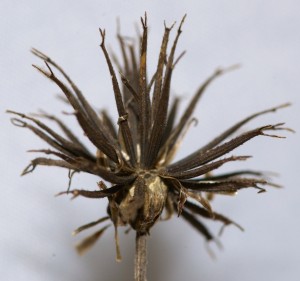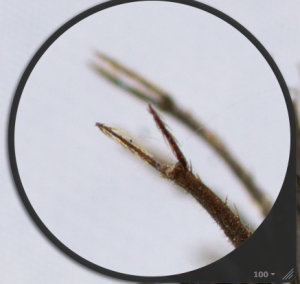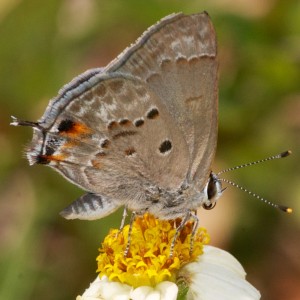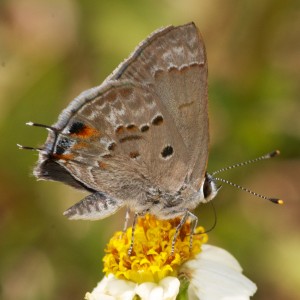More and more butterflies are appearing in front of my lens; I doubt that’s because there are in fact more butterflies in my yard. It’s much more likely that this phenomenon is the result of my camera lens being pointed outdoors more and more frequently as the north wind continues to keep the weather nice and my lunch breaks take advantage of it. (I am d-r-e-a-d-i-n-g the onset of the southerly breezes and their summer heat ‘n humidity, which can’t be far off, now.)
Today’s lunchtime views come to us courtesy of a couple of weedy species: the common weed Bidens alba, aka Spanish Needles, and the common butterfly, Strymon istapa, aka Mallow Scrub-Hairstreak. (To be fair, I should add a third weed species, Common Fanpetals, Sida acuta, which is the larval food for the butterfly.)
The first weed, which I try to pull up whenever I notice it on account of its wickedly clingy seeds (see below), nevertheless has a pretty flower with a yellow corolla and white petals. It provides much-needed pollen for many insects when there’s nothing else abundant and in flower. And if there’s one thing this flower can be said to specialize in, it’s abundance, on account of those aforementioned (and below-pictured) seeds. They are about 0.25–0.5 in (0.6–1.3 cm) long, ribbed, and individual seeds look somewhat like needles; they have from 2 to 6 barbed hooks at each end (most commonly two, bi-dens). The seeds are borne in loose round clusters that somewhat resemble the traditional “peony” firework display:

Here’s a close-up of those teeth:

As I found out from the Floridata page about this species, a single plant is capable of producing 3,000–6,000 seeds, which maintain viability for at least 3-5 years and germinate readily. If left unweeded, this little flower will soon carpet your property, causing untold annoyance when your toddler tramps through the weeds. Launderers and laundresses, beware the bidens! (I also found out that the “correct” common name of this plant is “shepherd’s needles,” but no one here in South Florida uses that name.)
As I mentioned, though, this little weed is very attractive to the local pollination crew; bees, butterflies, and even beetles, can’t seem to get enough of it. Floridata has a partial list of lepidopteran visitors to the blossoms:
[They] are a favored nectar source for many species including the great purple hairstreak (Atlides halesus), the dogface (Zerene cesonia) the red-banded hairstreak (Calycopis cecrops), the lantana scrub hairstreak (Strymon bazochii), and the gray hairstreak (Strymon melinus), and many others.
Our local scrub-hairstreak, the Mallow (Strymon istapa), is no stranger to this little flower, as you can see. Here it is, proboscis coiled as it anticipates how best to attack this scrumptious snack:

And here it is, proboscis uncoiled, rooting away among the multiple carpels (the “yellow stuff” that you see “inside” the flower):

I’ve written this species up before on this site, but since it was a short article and I didn’t have such a wonderful macro lens as I have now, I figured I’d give it a “relook” as they say on the subcontinent. Cech and Tudor highlight the characteristic that makes this butterfly so much fun for the photographer: “imperturbable.” As I said when I wrote it up last time, it stays put (“If only all butterflies—and any bird—were this easy to photograph!”)
As its name implies, its larval host plants are in the family Malvaceae; after puzzling over the identity of one of the many weeds in my yard, research conducted for this blog post clinched the ID for me: Sida acuta, aka common wireweed, aka common fanpetals, is the larval hostplant for this butterfly. Here’s a picture from the interblogs; I’m happy to report that, thanks to a recent bout of weeding, I don’t have any specimens worthy of photographing, although I do have several little ones that I need to get out of the ground:

If you want to know more about this plant, check out Stephanie Sanchez’s page over at heuristron.net; she’s always got something interesting to say!
This is one of the reasons I write this blog: I’ve been pulling this weed for over two years, never realizing that it’s the larval plant for one of my favorite little butterflies! From now on, when I weed this plant, I’ll be sure to leave a few behind (heh heh—as if it’ll be by choice!) in hopes of one day seeing the Mallow Scrub-Hairstreak caterpillar.
References
Cech, R. and G. Tudor. (2005). Butterflies of the East Coast: An Observer’s Guide. Princeton UP.
Minno, M. F., J. F. Butler, and D. W. Hall. (2005.) Florida’s Butterfly Caterpillars and Their Host Plants. Gainesville: UP of Florida.
